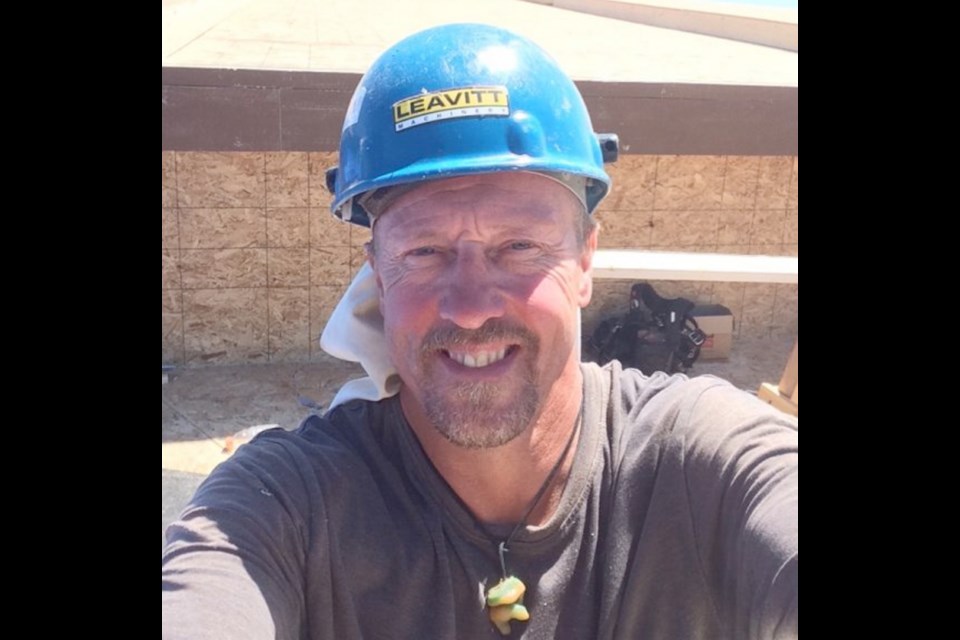The construction worker who died after plunging from the third floor of a Saanich condo should have been protected by tougher employment safety standards and a work stoppage in the face of high winds, says his girlfriend.
That stance is disputed by the project manager of the Shire condos on Inverness Road, who said an unforeseeable “rogue” wind preceded the fall and noted that WorkSafe B.C. sanctioned work to continue at the site’s other two buildings in the wake of the tragedy.
Corinne Desjarlais of Brentwood Bay is publicly questioning what she sees as inadequate safety measures in the hopes of preventing other workers from dying like Roland Huetzelmann did, from a severed spine and a skull that “looked like a crushed egg.”
Huetzelmann, 51, was knocked over a safety railing by a piece of plywood lifted by strong winds on Jan. 10. He fell 30 feet to the concrete below.
The veteran construction worker did not regain consciousness before dying of his injuries five days later in Victoria General Hospital.
“I want to make a difference for him,” said Desjarlais, calling him a good-hearted guy with a great work ethic. “There needs to be a change.”
She said there should have been a work stoppage given the high winds that day. Environment Canada had issued a wind warning and 10,000 customers in Greater Victoria suffered power outages attributed by B.C. Hydro to high winds.
Desjarlais said she and Huetzelmann discussed the bad weather the night before his fall. She asked “Why are you guys even up there?” given the harsh weather.
The B.C. Federation of Labour is also calling for more oversight, with president Irene Lanzinger saying Friday: “Why Huetzelmann wasn’t using a safety harness while working three storeys off the ground in high winds will be a central question for the Workers’ Compensation Board to delve into.”
Lanzinger said the federation shares concerns about the extreme cold and wind forecast for that day and suggested the province direct WorkSafe to ensure employers “implement appropriate safety procedures, including in some circumstances halting work on a project.”
Bill Thien, owner of Cedar Grove Framing and Huetzelmann’s employer, said: “Worker safety is and has always been my No. 1 priority. Before Christmas, I pulled Roland and other workers off the roof of a five-storey building for a week and a half due to the weather.”
Thien said he was walking down the stairs to unload lumber when the incident happened.
“There were six guys working on the floor when a gust of wind picked a 40-pound sheet of 5/8 plywood up off a stack of sheets and into Roland. The gust was so strong it pushed him through the handrail and off of the floor,” Thien said in an email.
“Prior to the incident, the winds were not strong. It was the perfect storm that caused this to happen.”
He said workers aren’t required to use harnesses when handrails are in place. “However, if Roland or any of my guys feel unsafe, there are harnesses on site for their use.”
Shire project manager Lyall Sargent said Jan. 10 was “breezy” with “a few small gusts but nothing that made us concerned. There were five to six workers up on the building, all of them experienced, and all of them felt safe,” Sargent said in an email to the Times Colonist.
He said that after the “extremely strong ‘rogue’ gust of wind,” no one on the site, including emergency responders and WorkSafe employees, seemed concerned with conditions. “WorkSafe cleared us to go back to work the same afternoon on the other two buildings.”
When there are weather warnings, they listen but exercise judgment, “as much of the time the weather does not unfold” as predicted, he said. As to whose call it is to work or not in extreme weather: “Everyone on site has a voice. Workers report conditions to us as they happen, and we respond.”
WorkSafe policy holds guardrails as the best form of protection from falls, and Sargent said the ones at the site of the fall were given verbal approval by the agency in the immediate aftermath of the incident.
“WorkSafe measured and tested our guards for strength post-accident, and their verbal response was ‘these are acceptable,’ ” he said, noting that the guardrails are temporary and not designed “for the type of driving force that occurred” before Huetzelmann’s fall.
Sargent said harnesses are not mandatory if there are guard railings, adding that safety harnesses can be problematic.
“Having six men up there all in harnesses on separate lines working around material and walls and braces is a tremendous hazard in itself and falling or tripping over these lines and then falling over the edge can also severely injure workers,” he said.
“Workers who fall off buildings with fall protection on have been seriously injured as well, as the jerking motion can break backs and necks as well as any ‘swinging’ motion into the building.”
Huetzelmann’s death is under investigation by WorkSafe B.C. Its reports show that falls from a height accounted for 92 deaths and more than 51,000 injuries between 2004 and 2013.
Desjarlais acknowledged that Huetzelmann was not coerced to work by his friend and employer Thien, whom she described as “good to his employees. He treated them well and we are all family.”
Huetzelmann was a generous man, with a great laugh, the youngest of six sons born in B.C. to parents who immigrated from Germany, settling in Powell River.
“He was a cutie and he was in really, really good shape,” Desjarlais said. “That’s why he survived as many days as he did. He had such a strong heart.”
He lived in Nanaimo for the past few years, but was staying with Thien while working for him in Victoria. “They were like brothers,” Desjarlais said.
A celebration of life will be held in Powell River on Jan. 28.



